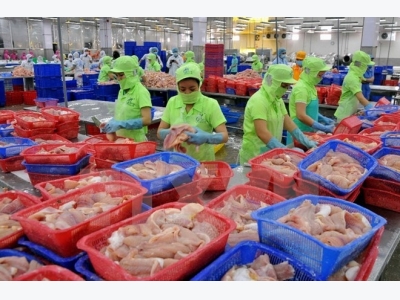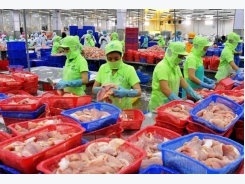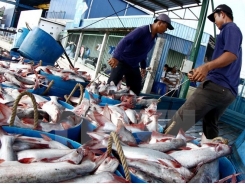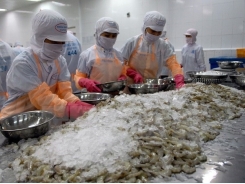Vietnamese tra fish stranded in US

All batches of products made from Siluriformers fish that are to be shipped to the US will have to undergo food safety tests from August 2, 2017, instead of September 1 (Source: VNA)
Hanoi (VNA) – Vietnamese tra fish processors and exporters are worried that it will cost more time and money to put their fish on plates in the US after the country announced ahead-of-schedule food safety tests on imported Siluriformers fish and fish products.
All batches of products made from Siluriformers fish, including tra, basa, tre and lang fish, that are to be shipped to the US will have to undergo food safety tests from August 2, 2017, instead of September 1.
The National Agro-Forestry-Fisheries Quality Assurance Department (NAFIQAD) under the Ministry of Agriculture and Rural Development (MARD) on July 10 sent this announcement to processors and exporters of Siluriformers fish after the department received a letter from the US Food Safety and Inspection Service (FSIS) under the US Department of Agriculture (USDA) through the US Embassy in Vietnam.
FSIS announced that all shipments of imported Siluriformers fish and fish products must be presented at an Official Import Inspection Establishment for re-inspection by FSIS personnel, according to the US Federal Register issued on July 3.
To apply for import re-inspection, applicants must submit a paper or electronic inspection application form to FSIS ahead of the shipment’s arrival and no later than when the entry is filed with the US Customs and Border Protection. The applicant must identify the official import inspection establishment where re-inspection will occur.
FSIS encouraged importers and brokers to communicate and coordinate with their respective FSIS District Office to facilitate compliance.
Truong Thi Le Khanh, Chairwoman and General Director of Vinh Hoan JSC, one of Vietnam’s leading tra fish exporters to the US, said Siluriformers fish and fish products are likely stuck in the US as construction of several official import inspection facilities in the US is still underway.
Sharing Khanh’s views, Truong Dinh Hoe, General Secretary of the Vietnam Association of Seafood Exporters and Producers (VASEP), said there are only 40 official inspection facilities authorised by the USDA scattered across the US. Few of them offer complete services while others specialise in only meat or frozen products.
He also expressed his concern over these facilities’ inability to perform food safety tests for Siluriformers fish and fish products, which, he said, may lengthen the duration of storage and FSIS inspections.
As a result, exporters will have to pay more storage fees and struggle to deliver their shipments on time, Hoa added.
Given this, he suggested the MARD work with the USDA to remove these bottlenecks.
Nguyen Nhu Tiep, head of NAFIQAD, told the Vietnam News Agency that in a diplomatic note sent to NAFIQAD, FSIS explained that the adjustment of the test schedule is in response to the US Congress’s Budget Control Act.
NAFIQAD then sent a diplomat note to FSIS expressing its concern over the change and suggesting the US create the best possible conditions for Vietnamese exporters to ensure the smooth delivery of Siluriformers fish to the market.
He further explained that businesses were not informed prior to the test schedule adjustment. Therefore, those who planned to ship Siluriformers fish to the US after August 2, 2017 will incur extra costs at official import inspection facilities.
NAFIQAD also urges local tra fish processors and exporters to contact US importers to learn more about new food safety regulations, he added.
At a recent conference on the tra fish sector in the Mekong Delta province of Tien Giang, Deputy Minister of Agriculture and Rural Development Vu Van Tam stressed that Vietnam will cooperate and negotiate simultaneously when penetrating the US market.
According to the VASEP, the US market has potential for pangasius fish products, however, the market has anti-dumping duties and technical standards that are too defensive and too strict, exceeding requirements for food safety.
Therefore, Vietnamese pangasius fish processors and exporters face many obstacles in exporting to the American market. In fact, only a few enterprises have been able to export to this market.
The US is currently thesecond largest importer of Vietnamese tra fish, behind China.
In the first four months of this year, Vietnam’s total export value of tra fish to the US stood at 90.2 million USD, a year-on-year drop of 21.7 percent
Related news
Tools

Phối trộn thức ăn chăn nuôi

Pha dung dịch thủy canh

Định mức cho tôm ăn

Phối trộn phân bón NPK

Xác định tỷ lệ tôm sống

Chuyển đổi đơn vị phân bón

Xác định công suất sục khí

Chuyển đổi đơn vị tôm

Tính diện tích nhà kính

Tính thể tích ao



 US Congress orders reinspection of all catfish imports…
US Congress orders reinspection of all catfish imports…  Shrimp export up nearly 16 pct in first…
Shrimp export up nearly 16 pct in first…